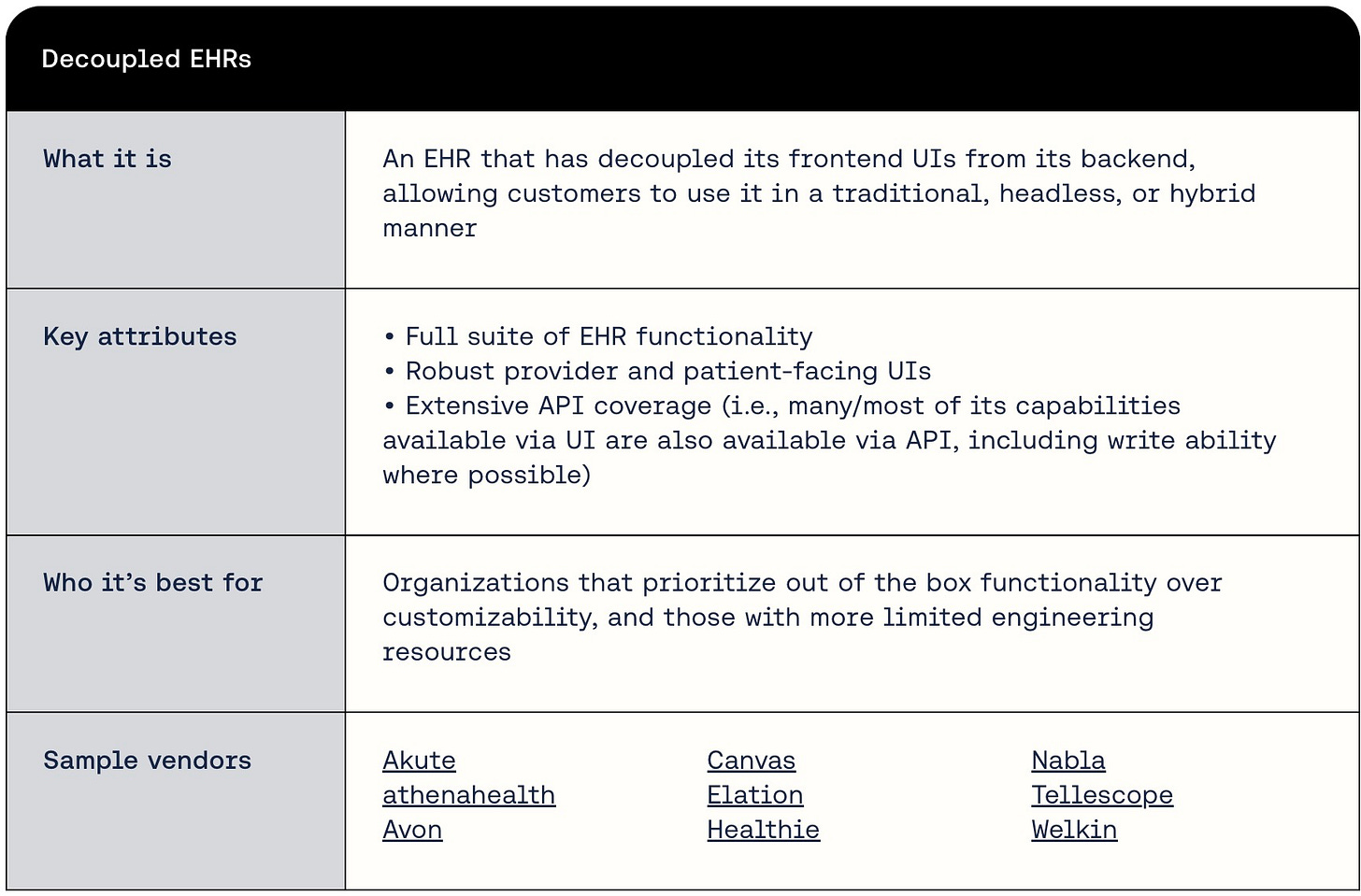The Evolution of FHIR and the Journey Towards Open EHR Systems: A Technical Analysis
Table of Contents
Introduction
Recent FHIR Advancements
2.1. FHIR R5 and API Maturity
Enhanced Search Capabilities
Bulk Data Access Optimization
Improved Terminology Services
Architectural Evolution
3.1. Microservices and FHIR
Resource-Oriented Decomposition
Event-Driven Patterns
3.2. Progress Toward Headless Architecture
API-First Design
Standardized Operations
Technical Challenges and Solutions
4.1. Performance Optimization
Caching Strategies
Query Optimization
4.2. Security Implementation
OAuth 2.0 and SMART on FHIR
Consent Management
Deterrents to Open EHR Adoption
5.1. Technical Barriers
Legacy System Integration
Performance Scalability
5.2. Business and Regulatory Challenges
Data Governance
Vendor Lock-in
Emerging Solutions and Best Practices
6.1. Architectural Patterns
API Gateway Implementation
Event Sourcing and CQRS
6.2. Implementation Strategies
Incremental Migration
API Versioning
Future Directions
7.1. Emerging Standards and Technologies
FHIR Shorthand
GraphQL Integration
7.2. Artificial Intelligence and Machine Learning
FHIR-Based Analytics
Automated Mapping
Conclusion
References
Introduction
The healthcare information technology (IT) landscape is experiencing rapid evolution, largely due to the adoption of Fast Healthcare Interoperability Resources (FHIR) and the demand for open, interoperable electronic health record (EHR) systems. FHIR is becoming the industry standard for enabling seamless data exchange and improving system interoperability, driving a shift toward open architectures and modular systems.
This paper explores recent advancements in FHIR, emerging architectural trends, technical challenges, and the industry’s journey toward creating truly open and headless EHR systems. By examining both the opportunities and obstacles, this analysis provides a comprehensive understanding of the current and future state of healthcare IT.
Recent FHIR Advancements
2.1. FHIR R5 and API Maturity
The release of FHIR R5 introduced several enhancements that improve the standard’s functionality and implementation efficiency.
Enhanced Search Capabilities
FHIR R5 revolutionized querying capabilities with the introduction of _filter parameters. These parameters allow for complex logical expressions and Boolean operations, streamlining data retrieval and reducing unnecessary traffic.
Example:
GET [base]/Patient?_filter=birthDate ge 2000-01-01 and (gender eq 'male' or gender eq 'female')
This advancement replaces concatenated parameter approaches, offering developers more precision and control over data queries.
Bulk Data Access Optimization
FHIR R5 enhanced bulk data export functionality, supporting both complete and differential exports. The asynchronous framework enables efficient data synchronization, reducing bandwidth usage and improving error handling.
Example:
GET [base]/$export?_type=Patient,Observation&_since=2023-01-01T00:00:00Z
This feature allows systems to stay synchronized in real-time, minimizing resource strain.
2.2. Improved Terminology Services
FHIR R5 introduced robust improvements to terminology services, including:
Enhanced CodeSystem capabilities: Support for hierarchical structures.
ValueSet composition rules: Enabling more complex value set definitions.
Concept mapping: Simplified terminology translations between systems.
These advancements foster more accurate clinical data exchanges and reduce complexity in multi-terminology environments.
Architectural Evolution
3.1. Microservices and FHIR
Microservices architecture has emerged as a key trend in healthcare IT, with FHIR serving as the backbone for system interoperability.
Resource-Oriented Decomposition
Healthcare systems now frequently decompose services into resource-specific domains, such as:
Patient Demographics Service
Clinical Documentation Service
Scheduling Service
Orders Management Service
Each service maintains its own datastore and exposes FHIR-compliant APIs, enabling modularity and scalability.
Event-Driven Patterns
Event-driven architectures using FHIR have gained popularity, leveraging:
Topic-based pub/sub with FHIR Subscriptions.
Event sourcing for audit trails and clinical data integrity.
CQRS for optimized read/write operations.
3.2. Progress Toward Headless Architecture
The transition toward headless EHR systems focuses on separating data access from presentation layers.
API-First Design
Modern EHRs prioritize API-first designs with FHIR at their core, enabling modularity and flexibility.
Standardized Operations
Standardized FHIR operations reduce vendor-specific dependencies, promoting openness and reducing vendor lock-in.
Examples:
POST [base]/Patient/$everything
GET [base]/Observation/$lastn
POST [base]/$convert
Technical Challenges and Solutions
4.1. Performance Optimization
Handling large data sets in real time remains a technical hurdle.
Caching Strategies
Resource-level caching with cache-control headers.
Search result caching for frequently queried combinations.
Denormalized structures for complex relationships.
Query Optimization
Materialized views for common queries.
Pre-indexing for search-heavy workflows.
Intelligent query planning using relationships.
4.2. Security Implementation
OAuth 2.0 and SMART on FHIR
SMART on FHIR supports fine-grained permissions and dynamic client registration for secure data access.
Consent Management
FHIR R5 includes enhanced consent resources, enabling granular control over patient data sharing.
Example:
{
"resourceType": "Consent",
"status": "active",
"scope": {
"coding": [
{
"system": "http://terminology.hl7.org/CodeSystem/consentscope",
"code": "patient-privacy"
}
]
}
}
Deterrents to Open EHR Adoption
5.1. Technical Barriers
Legacy systems rely on proprietary formats.Performance issues arise with real-time synchronization.
5.2. Business and Regulatory Challenges
Data Governance: Managing privacy and compliance effectively.
Vendor Lock-in: Proprietary APIs and extensions hinder openness.
Emerging Solutions and Best Practices
6.1. Architectural Patterns
API gateways ensure request routing and security.
Event sourcing/CQRS patterns enable scalability and audit trails.
6.2. Implementation Strategies
Incremental migration with FHIR facades.
Semantic API versioning to ensure smooth transitions.
Future Directions
7.1. Emerging Standards and Technologies
FHIR Shorthand (FSH): Simplifies implementation.
GraphQL Integration: Improves query flexibility.
7.2. Artificial Intelligence and Machine Learning
AI-driven analytics for population health.
Automated resource mapping for seamless integration.
Conclusion
The journey toward open EHR systems is marked by significant progress, driven by FHIR advancements and modern architectural principles. Challenges persist, but the adoption of best practices and emerging technologies holds the promise of a truly interoperable future for healthcare IT.
References
HL7.org. (2023). FHIR R5 Specification
SMART Health IT. (2023). Authorization Guide
OpenHIE Architecture Community. (2023). Implementation Guide


